
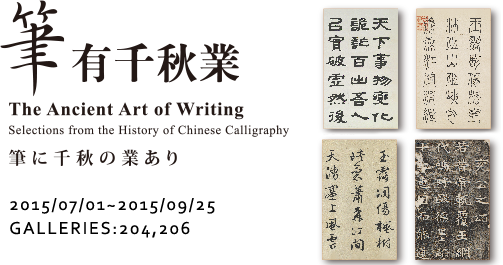

-

Stele Eulogy for Yangong
Bao Wengai, Tang dynasty (618-907)
Hanging scroll, ink on paper, 196.6 x 83 cmYangong ("Master Yan") is the name posthumously given to Yan Hui (521-481 BCE), Confucius' honored disciple, in the Kaiyuan reign (712-756) of the Tang dynasty. In the text, Governor Li Tinghui noted an inscription record for Xuanwang (Confucius), but none for Yan Hui. So he ordered Zhang Zhihong (Magistrate of Qufu) to compose the text, Bao Wengai to calligraph it, and had the stele erected in 742. The stele is now in the Temple of Confucius at Qufu, Shandong. The stele inscription avoids the taboo character of the Tang emperor Gaozu (566-635), changing Yan's style name from Ziyuan to Ziquan. Although the calligrapher, Bao Wengai, is unknown, the stele was still praised later by Bao Shichen and Kang Youwei in the Qing dynasty (1644-1911). They believed it to be most representative of Tang dynasty steles retaining the previous Six Dynasties style. Full of archaism and steadiness, it became an object of interest among calligraphy circles.
-

Letter to Yingshu, Grand Master Supervisor
Shen Liao (1032-1085), Song dynasty
Album leaf, ink on paper, 33.6 x 37 cmShen Liao (style name Ruida), a native of Qiantang (modern Hangzhou, Zhejiang) was known for his strong yet unusually beautiful writing, his poetry and prose also being in a style of his own. He also was good at calligra-phy, early studying the style of his ancestor, Shen Chuanshi (769-827) and later claiming to have studied the style of Wang Xizhi (344-386). Judging from the con-tents of this letter and the title of its recipient, Jiang Zhiqi, as Grand Master, this appears to have been written in 1083. In calligraphy, Shen Liao paid more attention to the idea than the brushwork, emphasizing the arrange-ment of character forms, which is why Mi Fu (1052-1107) critiqued his calligraphy as "arranged characters." This focus on composition also seen here can be found in the neat and orderly characters, the brushwork heavy and stocky but also with a slight sense of reservation. Some elements of cursive script also appear here and there among the lines to give the work a touch of anima-tion and to highlight its marvelous points.
-
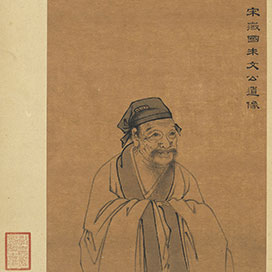
Letter
Zhu Xi (1130-1200), Song dynasty
Album leaf, ink on paper, 33.3 x 47.8 cm, 33.3 x 47.2 cmZhu Xi (style names Yuanhui, Zhonghui; sobriquets Hui'an, Huiweng, Kaoting xiansheng; alternate sobriquet Ziyang) was a grand synthesizer of Neo-Confucian thought in the Song dynasty, his ambition being to estab-lish a new order for the country. This letter was written in 1194 after leaving office as Administrator of Tanzhou (modern Changsha, Hunan) and on his way to the capi-tal; it deals with government matters in Tanzhou. Alt-hough he mentioned that Emperor Xiaozong had passed away in the sixth month, he still had the opportunity to go to the imperial court and teach following the ascen-sion of Emperor Ningzong (r. 1194-1224), turning sorrow into joy. This letter was written with great speed and force, the dots and strokes rich and full with lines steady and fluid. The line spacing is continuous overall, express-ing a manner of free and easy naturalness.
-
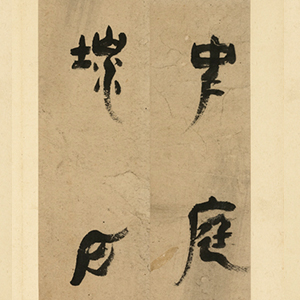
Wang Jian's "Viewing the Moon on the Night of the Fifteenth" in Seal Script
Hu Zhengyan (1584-1674), Ming dynasty Album leaf, ink on paper, 23.1 x 14.6 cm
Hu Zhengyan (style name Yuecong), a native of Xiuning in Anhui, resided at the foothills of the Jilong Mountains near Nanjing, naming his studio the "Shizu (Ten Bam-boo) Studio." Widely learned and gifted at writing, he delved into studies of the Classics and the Six Books. He also excelled at copying large and small seal script as well as unusual characters in ancient writing, being good at seal carving as well. His use of woodblock color printing to publish Painting and Calligraphy Manuals from the Shizhu Studio and Manual of Notepaper from the Shizhu Studio set the standard for traditional color printing in ancient times, being much appreciated by literati. Studied in seal and unusual script types, Hu also invented nu-merous unusual writing forms, this work being an exam-ple of such. The style here is magnificent yet eccentric, reflecting one facet in the trends for antiquity appreciat-ed by literati in the late Ming.
-
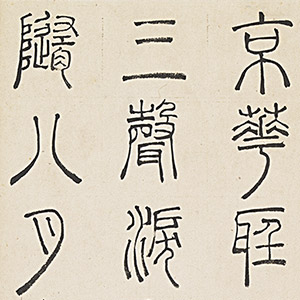
Du Fu's "Eight Poems on Autumn Thoughts" in Seal Script
Xu Chu, Ming dynasty (1368-1644)
Album leaf, ink on paper, 27.4 x 28.9 cmXu Chu (style name Yuanfu, sobriquet Gaoyang), a na-tive of Suzhou in Jiangsu, once served as Chief Recorder in the Court of the Imperial Stud. He enjoyed composing poetry and prose, carving seals, and doing calligraphy, frequently associating with the likes of Wen Peng (1498-1573) and Wen Jia (1501-1583). He was also a friend of the famous poet-writer Wang Shizhen (1526-1590). This album was written for Wang Shaogang, a friend of Wen Jia, in 1569. Xu Chu selected to transcribe Du Fu's (712-770) "Poems on Autumn Thoughts" in seal script, which was quite unusual at the time. Though done in seal script, elements of regular script are actually mixed in so that no particular brush method is being followed. The tip was hidden when applying and lifting the brush, making the dots and strokes appear like round stitched forms, adding an archaic yet interesting touch to the work.
-
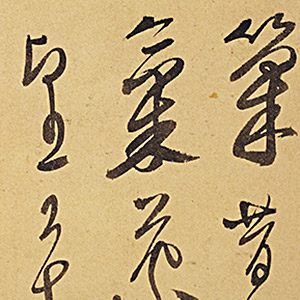
Eight Poems on Autumn Thoughts
Xu Wei (1521-1593), Ming dynasty
Album leaf, ink on paper, 29.2 x 35.9 cmXu Wei (style name Wenchang; sobriquets Qingteng laoren, Qingteng daoshi, etc.), a native of Zhejiang, was a man of many talents, including calligraphy, painting, po-etry, and drama. His life was filled with dramatic ups and downs expressed through his painting in the form of un-bridled emotions using sketched ideas in ink. In calligra-phy, he studied the style of Mi Fu (1052-1107) from the Song dynasty, developing an unbridled and animated manner as well. In art, he ranked his calligraphy first, fol-lowed by poetry and then painting, indicating how highly he considered his calligraphy. In this work, Xu Wei's elo-quent yet tortuous brushwork reveals lines that are full yet with tension, as if being further able to express the deep sorrow and heartfelt sincerity of the poetry by Du Fu (712-770).
-
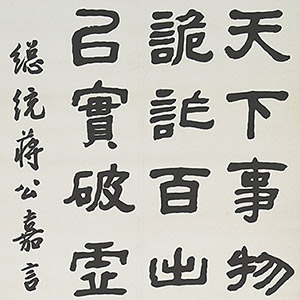
Maxim of Chiang Kai-shek
Tsao Jung (1895-1993), Republican period
Hanging scroll, ink on paper, 182.3 x 61 cmTsao Jung (style name Qiupu, sobriquet Laoxian, studio name Danlu), a native of Dadaocheng in Taipei, devoted his career to the teaching of calligraphy. Advocating a Zen-like approach to calligraphy, he was an important figure in local calligraphy circles. He was gifted at all script types and used a suspended wrist to do calligraphy, his brushwork in later years also including heaviness and archaism for an innocent and unaffected manner. This scroll was done in clerical script, the brushwork simple and straightforward with lines mellow and plain. The character forms are steady but also with variety for a beauty of naturalness and substantiality that has a ma-jestic manner within its serene atmosphere. Mr. Tsao Shu donated this work to the National Palace Museum.









